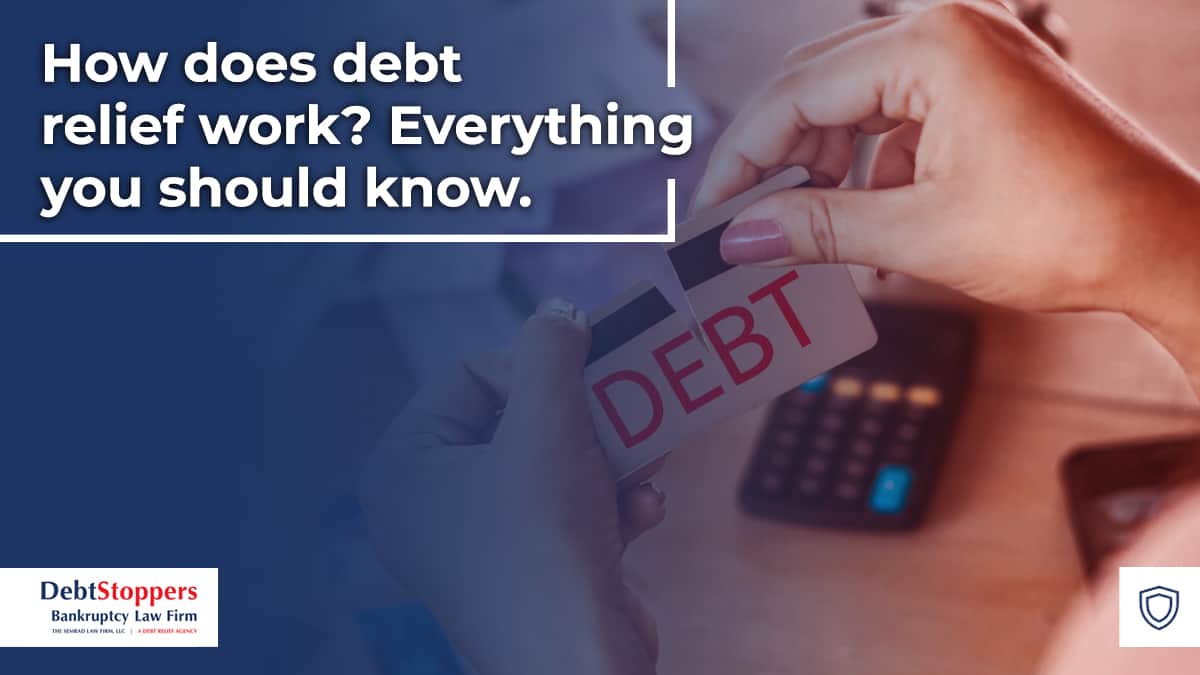How does debt relief work? Everything you should know.

Debt relief offers people struggling with debt an opportunity to regain control of their finances, reduce financial stress, and work toward a brighter financial future. There are several types of debt relief options and it is important to carefully consider the pros and cons of each option. This guide will explain everything you should know about how debt relief works.
What is debt relief?
Debt relief refers to various strategies and programs designed to help people manage, reduce, or eliminate their debt burdens. Debt relief can take many forms, and the specific approach depends on the nature of the debt, your financial situation, and the available options for resolving the debt.
Debt relief programs are typically used for specific types of debts such as credit card debt, medical bills, personal loans, and student loans. The three most common forms of debt relief include debt settlement, debt consolidation, and bankruptcy.

How does debt relief work?
Debt relief works by providing strategies and programs to manage, reduce, or eliminate debt. The specific process of debt relief can vary depending on the type of debt, the financial situation of the debtor, and the available options for resolving the debt.
Different debt relief strategies work in different ways. For example, debt settlement works by negotiating with creditors to settle debts for less than the full amount owed. Debt consolidation works by combining multiple debts into a single loan or repayment plan and reducing the interest rate or extending the repayment period. Bankruptcy provides an opportunity to eliminate or restructure your debt under the supervision of a bankruptcy court.
It is important to carefully consider the pros and cons of each debt relief option and seek guidance from qualified professionals to determine the best course of action based on individual circumstances.

What are the different types of debt relief?
There are several different types of debt relief options available. These options can vary in terms of eligibility, impact on credit, and long-term financial consequences. Three main types of debt relief include debt consolidation, debt settlement, and bankruptcy.
Debt consolidation
Debt consolidation involves combining multiple debts into a single loan or repayment plan, usually with more favorable terms, such as a lower interest rate or a longer repayment period.
Debt consolidation can simplify debt management and reduce the overall cost of borrowing but it may require collateral or a good credit score to qualify for favorable terms. The main debt consolidation options include:
-
Debt Consolidation Loan – This option involves taking out a new loan to pay off existing debts. The consolidation loan typically has a lower interest rate, and it combines multiple debts into one monthly payment.
-
Balance Transfer – Transferring high-interest credit card balances to a credit card with a lower interest rate can be a form of debt consolidation. Some credit cards offer promotional periods with low or zero interest rates for balance transfers.
-
Home Equity Loan or Line of Credit – Homeowners may use the equity in their homes to secure a loan for debt consolidation. This option may offer lower interest rates but it involves using your home as collateral.
One of the primary motivations for debt consolidation is to secure a lower overall interest rate, which helps reduce monthly payments and saves money on interest over the life of the loan. However, some debt consolidation options may involve fees, such as balance transfer fees or loan origination fees so it is wise to carefully consider these costs when evaluating the overall financial impact.
While debt consolidation can positively impact credit scores by reducing the number of open accounts and improving credit utilization ratios, it is important to be cautious. Opening new credit accounts or taking on additional debt can temporarily impact your credit score.
Debt consolidation is most effective when accompanied by a commitment to financial discipline. It is crucial to avoid accumulating new debt while working to pay off the consolidated loan. If you are considering debt consolidation, you should carefully weigh the benefits and potential drawbacks, and seek professional advice to make informed decisions based on your circumstances.
Debt settlement
Debt settlement involves negotiating with creditors to settle debts for less than the full amount owed. Debt settlement companies usually work on behalf of the debtor to negotiate lump-sum or structured settlements with creditors, often resulting in significant reductions in the total debt balance.
The debt settlement process typically involves assessing your financial situation, developing a budget and plan for saving, negotiating with creditors to reach settlements, and establishing a structured repayment plan. Instead of making regular payments to creditors, people using a debt settlement program usually make monthly payments into a savings account managed by the debt settlement organization. These funds are then used to negotiate settlements with creditors.
There are non-profit and for-profit debt settlement organizations, before selecting a debt settlement company or organization it is important to understand the terms and fees associated with their services.
Bankruptcy
Bankruptcy is a legal process that allows individuals or businesses to eliminate or restructure their debts under the supervision of a bankruptcy court.
Overall, bankruptcy can provide people with a fresh start by addressing overwhelming financial challenges. Bankruptcy may eliminate certain debts that cannot be discharged through other debt relief methods. For example, income tax debt that meets specific criteria may be dischargeable in bankruptcy. Additionally, bankruptcy laws provide exemptions that protect certain assets from liquidation. This allows individuals to retain essential property, such as a primary residence, personal belongings, and retirement accounts.
Under Chapter 7, some unsecured debts, such as credit card balances and medical bills, may be discharged, which means you are no longer legally obligated to repay those debts.
Chapter 13 bankruptcy involves the development of a repayment plan to repay debts over three to five years so you keep your assets and make more manageable payments.
When you file for bankruptcy, an automatic stay goes into effect. This legal injunction halts most collection actions by creditors, including lawsuits, wage garnishments, and harassing collection calls. The automatic stay provides immediate relief and allows you to focus on the bankruptcy process.
Who is eligible for debt relief?
Eligibility for debt relief programs varies depending on the specific program, the type of debt, and your specific financial circumstances. While there is no one-size-fits-all answer to who is eligible for debt relief, certain factors may increase the likelihood of qualifying for assistance.
Debt relief programs are often designed for people experiencing financial hardship, such as unemployment, reduced income, medical emergencies, divorce, or other significant life events that have affected the ability to manage debt.
Debt relief programs typically target specific types of debts, such as credit card debt, medical bills, personal loans, student loans, tax debts, or mortgage debt. Eligibility for debt relief programs often depends on the creditors involved and the amount of debt owed.
Some debt relief options, such as debt settlement or bankruptcy, may consider your income and assets when determining eligibility. For example, to qualify for debt settlement, you may need to demonstrate financial hardship or an inability to repay your debts in full. Similarly, Chapter 7 bankruptcy eligibility may depend on income levels and passing a means test.
Eligibility for debt relief depends on a combination of factors specific to the individual's financial situation and the requirements of the debt relief programs available. A qualified bankruptcy attorney can help you assess your financial situation, explain available options, and provide guidance on the best course of action to address your debt problems and achieve financial stability.
Which are the top debt relief organizations?
Debtstoppers is Illinois’ #1 debt relief organization. Debstoppers has helped thousands of people with debt relief and our experienced attorneys will be your ally every step of the way.
Debtstoppers has been an accredited business with the Better Business Bureau since 2014 with zero customer complaints!
Schedule a free consultation today to talk to one of our experienced debt relief attorneys who can help you understand your options and determine your best course of action.





